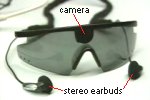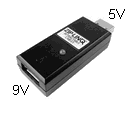This web page is obsolete and will no longer be maintained.
Many commercial video sunglasses with a hidden
CCD or CMOS camera, as used by blind users of The vOICe,
are analog devices that need a separate video capture device plus a separate
power supply for interfacing with a notebook PC.
There exist various convenient USB video capture devices for getting the analog (NTSC/PAL)
video signal into the computer, but it would be most convenient if video sunglasses
could also be powered directly by the notebook PC or netbook rather than having
to use a separate (rechargeable) battery pack for the glasses. This page describes
a simple solution that gets around the need for a separate battery pack altogether by
![]() using a commercially available cheap USB DC-DC converter and an adapted USB extension
cable.
using a commercially available cheap USB DC-DC converter and an adapted USB extension
cable.
|
A regular USB port has four pins: two for 5 volt DC power and ground, and two for data.
Video sunglasses typically require a DC supply voltage well above 5 volt, such that the
5 volt of a USB port does not suffice. With many video sunglasses, the allowed supply
range includes 9 volt DC. Please check the technical specifications of your choice of
video sunglasses: on this page we will assume that the video
sunglasses accept a 9 volt DC supply voltage while drawing a current of less than 300 mA
(milliamp). So then we need a device that converts a USB port's standard 5 volt into
9 volt for the video sunglasses.

 Technically such a device is known as a DC-DC converter or voltage converter, and
fortunately a suitable USB DC-DC converter is on the market in the form of a phone
charger accessory. Specifically,
Technically such a device is known as a DC-DC converter or voltage converter, and
fortunately a suitable USB DC-DC converter is on the market in the form of a phone
charger accessory. Specifically,
![]() Zip-Linq
(
Zip-Linq
(
| |||||||||||||||
Finally, it is advisable to fix (tape or glue) the modified USB cable to the USB DC-DC converter to minimize any chances of inadvertently connecting a regular USB device to the output of the USB DC-DC converter, of course assuming here that the barrel connector used to power the video sunglasses will also not get connected to any other devices that might have a plug of the same dimensions.
|
Most or all USB video capture devices will readily connect to the video signal lead of your video sunglasses, but the power lead connecting the USB voltage converter output to the video sunglassses' power supply connector needs to be assembled as indicated above, because such a lead is not (yet) available on the market.
Now, one can create a convenient wearable setup for daily use of The vOICe with video sunglasses, with everything powered by the portable PC's built-in battery. A representative wearable setup for The vOICe will thus comprise a notebook PC or netbook inside a backpack. A USB video capture device and USB power supply (the voltage converter) are plugged into two separate USB ports on your notebook PC or netbook. The USB video capture device captures the video signal from your video sunglasses, while the USB power supply powers your video sunglasses. Stereo headphones plug right into the headphones connector of your notebook PC or netbook.
Application note: the approach described above can according to user reports also be applied with the Lego Mindstorms NXT brick (normally powered by 6 AA batteries in comsumer version) and the Lego NXT Camera (9 volt camera with wireless NTSC transmitter).